
White Chocolate Low Histamine Coffee Drink
This white chocolate low histamine coffee drink will warm you up from the inside out.
You’ll enjoy this tasty treat that fits the low histamine diet!
This drink puts you in the holiday spirit with spicy ginger, rich coconut milk, and creamy white chocolate.
It can even benefit your health!
Keep reading to:
- Learn more about a beneficial compound found in coffee called trigonelline
- Get the coupon code for our favorite low histamine coffee
- Learn more about chocolate vs white chocolate
- Get the recipe for this low histamine white chocolate coffee drink
This recipe is:
- Low histamine
- Low oxalate
- Low lectin
- Low FODMAP
- Dairy free
- Gluten free
It’s important you know that this blog post is for informational and educational purposes. It’s not meant to treat any health condition or to be prescriptive for anyone. If you have any medical condition, it is critical you work under the care and guidance of a licensed medical provider.
White Chocolate Low Histamine Coffee Drink
For some people, coffee is almost synonymous with mornings.
For others, it plays a big part in social interactions. Let’s meet for coffee!
Whether you drink it black, with a little cream, or more like a dessert drink, coffee is a treat we keep coming back for.
We’re proud to feature Purity coffee whenever we can.
For years, several of our team members struggled with other brands of coffee (even decaf).
After drinking coffee, we’d sometimes get tummy aches, the jitters (yes, even decaf), and just a general icky feeling.
With Purity, our tummies don’t churn, and we don’t get anxious or nauseated. Our coffee time is pure enjoyment again.
Many of our clients have been able to successfully reintroduce coffee into their mornings, too.
We’ve been fans of Purity for many years now. Purity is a high-quality coffee. They are dedicated to delivering a healthy product to their consumers.
The following attributes may contribute to Purity being better tolerated for those with Mast Cell Activation Syndrome (MCAS), Mold Toxicity, and Histamine Intolerance.
Their coffee is:
- Organic – no pesticide residue to trigger mast cells
- Mold-free – mold is a known mast cell trigger
- Mycotoxin-free – won’t undo the work you’ve done to detox
- Roasted to optimize antioxidants and micronutrients
- Low histamine
- And their decaf is 99% decaf compared to some brands which are only 97%
As a bonus, Purity coffee practices regenerative farming and is Smithsonian Bird Friendly Certified.
Smithsonian Bird Friendly Certified means that Purity farms have met strict standards including:
- Certified organic
- Deforestation-free
- Habitat protection for wildlife
Love that!
You can enjoy your cup of coffee even more when you know that it has health benefits, too!
Our favorite Purity Coffee is currently having a sale!
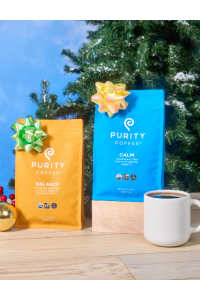
>>> Save 20% through November 25 on all Purity Coffee with code MASTCELL360
Health Benefits of Coffee: Trigonelline
Trigonelline is the second most abundant alkaloid found in green coffee beans.
It contributes to the flavor and aroma of coffee.
Studies have shown that trigonelline has many potential benefits.
Animal studies have shown trigonelline exhibits beneficial properties such as being:
- Neuroprotective (brain health) – including memory function and reducing migraines
- Hypoglycemic (lowering blood sugar) – for metabolic health and blood sugar regulation
- Hypolipidemic (lowering fat levels in the blood) – for cardiovascular health
- Antimicrobial – antibacterial and antiviral
Trigonelline has also been shown to have anti-inflammatory properties.
Further, trigonelline has been shown to inhibit mast cell degranulation.
Mast cell degranulation is another way of saying what happens when mast cells are triggered and release chemical mediators (such as a release of histamine). This can contribute to elevated histamine levels in your body.
Related Article: What Are Mast Cells? Mast Cell Activation Syndrome 101
A low histamine diet can help lower histamine levels. So can taking supplements like diamine oxidase (DAO), the histamine degrading enzyme.
Further, you can support your body with healthy foods. In this case, the trigonelline in coffee may be helpful in lowering histamine on some level.
When you can get benefits from your favorite foods, that feels like a win-win!
So, enjoy your cup of coffee for health!
Is White Chocolate Low Histamine?
With this recipe, we took inspiration from the flavored lattes you get from the big chain coffee shops.
One of the ingredients we used was white chocolate.
White chocolate is a low histamine food.
Types of chocolate like dark chocolate and milk chocolate are high histamine foods.
White, dark, and milk chocolate are all made from cocoa butter, the fat component of cocoa beans. So, why is one lower histamine?
Dark chocolate and milk chocolate contain cocoa solids. Solids are the dry, non-fat portion of the cacao bean.
White chocolate doesn’t contain these solids.
The cocoa solids are what put dark chocolate and milk chocolate on high histamine foods lists.
In this recipe, we’ve used white chocolate to add creaminess and decadence to this coffee treat. You may see white chocolate sold as cacao butter or cocoa butter, too.
When choosing white chocolate, stick with organic products without additives or preservatives that may be mast cell triggers.
And choose a product without any added sweeteners.
You’ll add your own sweetener. This gives you control over the sweetness level, as well as being able to choose a low histamine sweetener like stevia.
This delicious drink was a big hit with our friends and family.
We’re serving this tasty treat hot, but you can have it iced if that’s your preference.
Just remember to start with a high-quality coffee like Purity! It makes a world of difference for those with Mast Cell Activation Syndrome and Histamine Intolerance!
Related Article: Low Histamine and Mold-Free Coffee for MCAS: Why Purity Coffee Might Put a Cup Back in Your Mornings
Here’s the coupon code again for you!
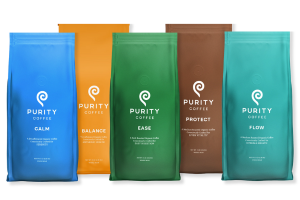
>>> Save 20% through November 25 on all Purity Coffee with code MASTCELL360
What to Serve with White Chocolate Low Histamine Coffee Drink
- Fresh Fruit Cobbler – Low Histamine, Medium Oxalate, Low Lectin
- Low Histamine Cranberry Crumble Bar Recipe – Low Oxalate, Low Lectin, Low FODMAP
- Muffin Recipe: Blueberry Cassava Flour Muffins – Low Histamine, Medium Oxalate, Low Lectin, Low Salicylate Option
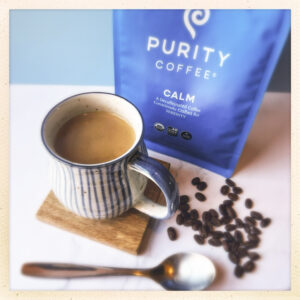
White Chocolate Low Histamine Coffee Drink
Equipment
- Small Pot
Ingredients
- 1 cup Purity Coffee (about 8 ounces brewed)
- 1 teaspoon Native Forest Coconut Milk
- ⅜ teaspoon Fresh Organic Ginger grated
- 2 Tablespoons Organic Cacao Butter
- 5 drops Stevia (add to taste)
Instructions
- Brew coffee as you normally would. We prefer the pour over method.
- Peel ginger and grate using a microplane grater.
- In a small pot over medium heat, combine the brewed coffee with the coconut milk, grated ginger, and cacao butter. Stir continuously until the cacao butter is melted (about 2 to 3 minutes).
- Pour into a mug, add stevia to taste and enjoy!
Notes
Nutrition
Did you enjoy the white chocolate low histamine coffee drink? What other coffee shop treats would you like to see recipes for? Leave a comment to help us know what you’d like for future recipes!
More Low Histamine Beverages
- Frozen Vanilla Coffee Cooler – Low Oxalate, Low Lectin, Low FODMAP
- Elderflower Sparkling Wine Cocktail Recipe – Plus Mocktail Option – Low Oxalate, Low Lectin, Low FODMAP
- “Pumpkin Spice” Drink Recipe – Low Oxalate, Low Lectin, Low FODMAP
The website provides approximate nutrition information. Users should calculate the nutritional information with the actual ingredients and quantities they use in their recipes for the most accurate representation.
Some links in this website are affiliate links, which means Mast Cell 360 may make a very small commission if you purchase through the link. It never costs you any more to purchase through the links, and we try to find the best deals we can. We only recommend products that we love and use personally or use in the Mast Cell 360 practice. Any commissions help support the newsletter, website, and ongoing research so Mast Cell 360 can continue to offer you free tips, recipes, and info. Thank you for your support!
References
Castro-Díaz, R., et al. (2025). The antimicrobial effects of coffee and by-products and their potential applications in healthcare and agricultural sectors: A state-of-art review. Microorganisms, 13(2), 215. https://doi.org/10.3390/microorganisms13020215
Dala-Paula, B. M., et al. (2021). In vitro bioaccessibility of amino acids and bioactive amines in 70% cocoa dark chocolate: What you eat and what you get. Food Chemistry, 343, 128397. https://doi.org/10.1016/j.foodchem.2020.128397
HappyForks. (n.d.). Recipe analyzer. https://happyforks.com/analyzer
Khalili, M., et al. (2018). Trigonelline mitigates lipopolysaccharide-induced learning and memory impairment in the rat due to its anti-oxidative and anti-inflammatory effect. International Immunopharmacology, 61, 355–362. https://doi.org/10.1016/j.intimp.2018.06.019
Kritas, S. K., et al. (2018). Impact of mold on mast cell-cytokine immune response. Journal of Biological Regulators and Homeostatic Agents, 32(4), 763–768.
Nguyen, V., et al. (2024). Pharmacological activities, therapeutic effects, and mechanistic actions of trigonelline. International Journal of Molecular Sciences, 25(6), 3385. https://doi.org/10.3390/ijms25063385
The Chronic Fatigue (ME/CFS) Clinic at Johns Hopkins. (2025). Low Histamine Diet. In Hopkins Medicine. Johns Hopkins. Retrieved November 11, 2025, from https://www.hopkinsmedicine.org/-/media/johns-hopkins-childrens-center/documents/specialties/adolescent-medicine/cfs-low-histamine-diet.pdf
Zhang, W., et al. (2021). Trigonelline, an alkaloid from leonurus japonicus houtt., suppresses mast cell activation and OVA-induced allergic asthma. Frontiers in Pharmacology, 12, 687970. https://doi.org/10.3389/fphar.2021.687970
Zhou, J., Chan, L., & Zhou, S. (2012). Trigonelline: a plant alkaloid with therapeutic potential for diabetes and central nervous system disease. Current Medicinal Chemistry, 19(21), 3523–3531. https://doi.org/10.2174/092986712801323171

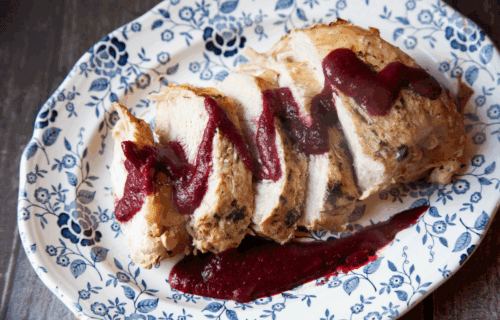
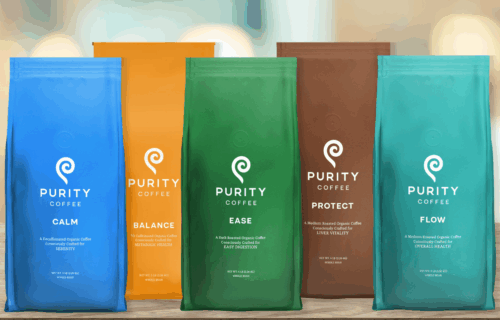

Add A Comment